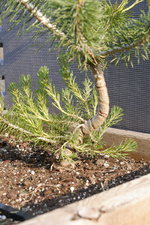A point that seems to be missed regarding the videos being posted is that the grower is showing how he develops tiny shohin pines, where the branches need to be kept very short and thin while developing the trunks. Others are sharing how they developing slightly larger (even if only slightly bigger than shohin) pines. There could be some nuances and differences in how development occurs or can be carried out in different size pines.
Tiny shohin? You mean the Takamatsu bonsai videos? Of course these are smaller. But the reason they are small is because of their age.
But I don't think the OP is trying to grow for 40 years to develop 1m high pine bonsai.
One of my regrets is actually that the pine trunks I grew aren't really suitable for smaller bonsai. Don't most people want bonsai in the 20 to 40cm in height range? Which they can easily lift alone?
One part of energy management would be to make sure the trunk doesn't get too large. You very easily get long internodes and leggy branches.
It would actually make sense that if you field grow trunks for bonsai, that after 10 years you can at least harvest a few of them and work them.
There is also a difference between growing in pot vs growing in the field. But I think the main point I raised is fair. And addresses directly the topic subject. When do you start to balance? After 10 years? Or after 1 year?
I'd say that after growing just a few pines over a 10 year period, one absolutely has to start thinking about bonsai, branching, energy balance in year 1.
I agree with the advice of trying to keep as much needle mass as long on the trunk as possible. As well as for major branches, reducing them to 2 per node, to prevent reverse taper.
And that of those two, 1 should be an option for a branch in the final design, and the other either a sacrificial branch, or a potential sacrificial branch.
And those weaker buds, you want to nurture them to try to see if they can become candidate branches or even candidate new leaders. You want to break up the node-internode-node pattern by using these in a final design.
You nurture weaker buds by stepping in and weakening the stronger buds; energy balance. How to manage this exactly, I am not sure. I tried needle plucking, but I am not sure if that actually had as much effect on strength.
I didn't do good side by side experiments.
The guy in the Takamatsu bonsai videos prunes very strongly all branches, even during the development stage.
I wonder if with Scot's pine, pruning off the new candles, leaving just 6 needles, quite early on, every other year, may be a good strategy. It will slow things down, but maybe improve the quality of what you get.
That is what I would try if I start to grow pines once more.

















